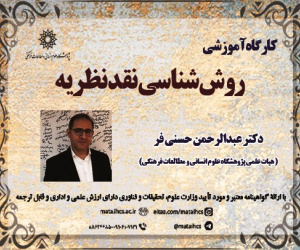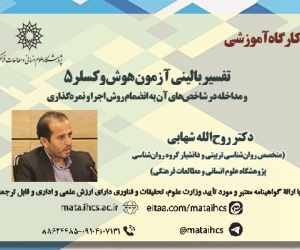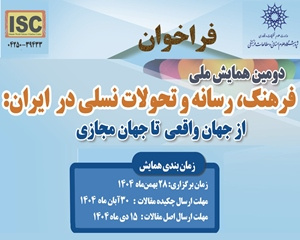نقد و تحلیل شیوه نامه های نگارش و ویرایش فارسی (مطالعه موردی: نشانه گذاری) (مقاله علمی وزارت علوم)
درجه علمی: نشریه علمی (وزارت علوم)
آرشیو
چکیده
پس از رواج صنعت چاپ به صورت مدرن از دهه سی شمسی به این سو، شیوه نامه های فراوان و گوناگونی برای نشان دادن کاربرد درست علائم نگارشی (نشانه گذاری) تدوین شده است؛ با گذشت زمان، هم تعداد علائم نگارشی فزونی یافته است و هم نویسندگان شیوه نامه ها کوشیده اند، مسائل گوناگونی برای کاربرد هریک از علائم نگارشی به مخاطبان پیشنهاد دهند تا چیزی از دایره شمول قواعد آنها بیرون نماند. اکنون انبوهی از شیوه نامه ها در دسترس همگان است، بی آنکه در بسیاری از آنها بتوان قاعده ای نو یا متفاوت با قواعد موجود قبلی یافت. این درحالی است که نقد و ارزیابی دقیقی درباره پیشنهادهای نویسندگان این شیوه نامه ها برای کاربرد علائم نگارشی منتشر نشده است. در پژوهش حاضر هجده شیوه نامه رایج که در آن به کاربرد علائم نگارشی پرداخته اند، به روش تحلیلی و انتقادی بررسی شده است؛ در ضمن آن، تناقض های درونی، اختلاف دیدگاه های نویسندگان و افراط و تفریط های آنان با رعایت اصل اعتدال، در قالب شاهدها و مثال های آنان نقد و ارزیابی می شود؛ در پایان هر بخش، درباره اختلاف ها، پیشنهادهایی ارائه شد تا زمینه ای برای بازنگری در تدوین شیوه نامه ها فراهم آید و با کاسته شدن تشتّت شیوه های ویرایش، نارسایی های مفهومی ناشی از کاربرد نابجای علائم نگارشی نیز زدوده شود. گفتنی است در پژوهش حاضر سعی بر این است تا حدّ امکان از تعداد کاربردهای علائم نگارشی کاسته شود؛ زیرا افزایش پیشنهادهای نویسندگانِ شیوه نامه ها تشخیص کاربرد ها را برای ویراستاران و دیگر کاربران دشوار می کند.A Critical Analysis of Persian Manuals of Writing and Editing (Case Study: Punctuation Marks)
As the Iranian printing industry entered its modern era in the 1950s, manuals of style began to flourish with sets of writing and editing guidelines for correct punctuation and text formatting. Over time, the writing symbols have increased in number, and manual organizers have tried to make their guidelines inclusive by proposing new rules and usages for the symbols. Nowadays, a great number of such manuals are publicly accessible, but there is hardly any novelty or difference from the past in them. Besides, no attempts have been made to accurately evaluate or criticize the proposed orthographic signs and symbols and the tips on how to use them. To fill the gap, the present study examines eighteen commonly used writing style manuals through a descriptive-analytical method. The aim is to shed light on the contradictions within the individual manuals and among them, the differences in the authors’ views, and the excess and defect in their approaches. This is a just and fair task of evaluation done with a bulk of examples as proofs and evidence. Each section of the research ends up with some suggestions about how to revise the set-up of guides and manuals on writing so as to reduce the inconsistencies and eliminate the textual inexpressiveness that stems from the wrong use of punctuation marks. The number of such marks presented in this study is kept as low as possible because too many suggestions would make it hard for editors and users to discreetly select and apply the intended marks. Introduction Coinciding with the birth of the publication industry, more precisely in the wake of 1330 AH, manuscript editions using mechanics of writing, more particularly punctuation marks, increased significantly prior to publication at academic centers and publishing industries. The importance of this issue inspired many editors and authors to compile manuals and dedicate a section in books with the general title of mechanics of writing to explicate the use of punctuation marks. Considering existing multifarious and diverse manuals, and the paucity of studies on such writings (more significantly, the punctuation marks), the present study aims to analyze the aforementioned texts and uses of punctuation marks to highlight obscurities and provide a review and critical study of opposing views, in the hope of improving text consistency. Materials and Methods Taking an analytical and critical method, the present study reviews 18 conventional manuals which have examined punctuation marks. It also evaluates the internal contradictions, and variety of views, and then moderately touches on excessive adherence to rules, with all examples and evidence in their texts. The concluding section provides suggestions on differences that would likely foreground revision of given manuals and eliminate dispersed editing methods and the conceptual incompetency caused by inappropriate uses of punctuation marks. Research Findings There were varied opinions on using the question mark in several specific cases, and several punctuation marks for a particular purpose, such as 1) Interrogative sentences inferring a rhetorical question, 2) Interrogative sentences used for inquiries or polite requests, 3) Recurring use of question marks, and 4) Question marks inserted in brackets. The following presents the frequent uses of question marks: 1) closing direct question sentences, and 2) adding in parentheses to shed doubt on the author’s intention or ambiguity of the text and in hooks to highlight the author’s sense of doubt or cited texts. Exclamations were also treated differently; either following 1) an exclamatory sentence, 2) sounds, 3) within the parentheses, and 4) coupled with a question mark. There are different views, which are subject to criticism, on using periods that may appear either in imperative sentences or conventional abbreviations. In this sense, there are several possible uses to consider a period: 1) at the end of declarative and imperative sentences, 2) short answers, 3) abbreviations, 4) indirect questions, 5) at the end of citations within the text or at the end of the text, 6) separating parts of web addresses, 7) at the end of a direct quotation, and 8) following quotation marks. There are diverse views and ambiguities concerning the use of semicolons such as 1) followed by parallel pairs separated by ‘and’ (wa) , 2) conjunctions such as because (zirā) , or however (ammā) , 3) separating options (when each of the options are separated by a semicolon and the final point takes a period). It can be thus regarded that semicolons are followed by linking words such as because (zirā) , however (ammā) , but (walī) , therefore (banābarīn) , while (dar ḥālī kih) , hence (dar natījah) , for instance (barāy-i mithāl) , meaning (ya’nī) , in this sense (az īn rūy) , in a way that (bi ṭūrī kih) , within the separate components of a general category (while each segment is separated by a semicolon and the final point ends with a period), in-text citations to two or more sources, within conditional sentences or sentences consisting multiple commas, within seemingly independent sentences that are semantically interrelated. Exploring how manuals refer to the uses of commons, the researchers noticed the specific differences 1) among parallel words, 2) following and followed by the post-positioned particle in Persian rā, 3) following the subject, 4) following short answers, and 5) following that (kih) . The study shows that commas are prevalently used 1) following an exclamatory sentence, 2) between the dependent and independent sentences (when the dependent clause precedes the main clause, a comma is used and when the independent clause precedes the dependent clause, a semicolon is applied), 3) among parallels, 4) between the phrase and similar sentences, 5) in either part of an exclamatory sentence, non-restrictive clause, or appositions, 6) between two repeated words, 7) following adverbial clauses at the beginning of the sentence, 8) replaced for nouns and verbs, 9) for clarification, and 10) to separate addresses, sources, numbers, surnames and names, book titles, and author’s names. Discussion of Results and Conclusion The substantial issues observed in consulted manuals include the use of examples rather than evidence, the incongruity between uses and examples to support suggested punctuation marks and their uses, ambiguities or content incompetency in using mechanics and providing an amalgam of rhetorical and grammatical points. Writing mechanics eliminate mistakes ambiguities and improve proper understanding of the text; however, excessive use of punctuation marks which also consists of diverse instances or suggestions, and discourages users to adhere to conventions. It is noteworthy that punctuation marks ought to be applied on the account of textual and contextual perquisites, though there might be exceptions given the rules and conventions of every punctuation mark. To eliminate obfuscations, it is suggested to include an introductory section in glossaries and encyclopedias, indicating compilers’ preferences for applied punctuation marks. It is also recommended to consider the denotative aspect of punctuation marks in particular sciences, as some marks convey a significant meaning in specific areas of knowledge.







